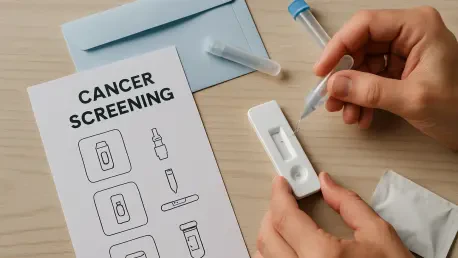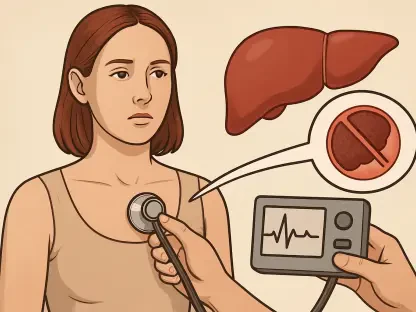Imagine a silent epidemic creeping into the lives of younger adults, where a deadly disease like colorectal cancer is becoming a leading cause of cancer-related deaths among men under 50 and the second leading cause among women in the same age group. Despite the U.S. Preventive Services Task Force lowering the recommended screening age from 50 to 45 in response to this alarming trend, participation remains shockingly low, with fewer than 2% of eligible adults aged 45 to 49 getting screened within 20 months of the guideline update. This gap in public health efforts represents a missed opportunity to catch a preventable and treatable disease early, highlighting the urgent need for innovative strategies to engage a demographic that may not yet recognize their risk. A groundbreaking study from UCLA, published in the Journal of the American Medical Association (JAMA), offers a compelling solution by demonstrating how simple interventions can make a significant difference in screening uptake.
The research, led by Dr. Folasade May of UCLA Health, delves into various outreach methods designed to boost participation among this newly eligible age group. Among the approaches tested, one stands out as a potential game-changer: mailing at-home stool-based tests, known as Fecal Immunochemical Tests (FIT kits), directly to patients without requiring them to take any initial action. This automated strategy sidesteps common barriers like procrastination or lack of awareness, providing a low-effort path to potentially life-saving screening. With colorectal cancer rates continuing to climb among younger adults, the findings from this study could reshape how preventive care is delivered, offering a scalable model to close critical gaps in early detection and ultimately save lives.
Understanding the Need for Screening
Rising Incidence in Younger Adults
The alarming surge in colorectal cancer cases among adults under 50 has become a pressing concern for public health experts worldwide. Once considered a disease primarily affecting older populations, this type of cancer is now striking younger individuals at an unprecedented rate, making it a top cause of cancer mortality in men aged 20 to 49 and a close second for women in the same bracket. This shift in epidemiology prompted the updated screening guidelines, yet the low uptake among those aged 45 to 49 reveals a disconnect between policy and practice. Many in this age group may feel invincible or unaware of their risk, often delaying screening until symptoms appear—by which point the disease may have advanced. Addressing this trend requires not only raising awareness but also rethinking how screening is offered to fit the lifestyles and mindsets of younger adults who might not prioritize preventive health measures.
Early detection remains the cornerstone of effective colorectal cancer management, with the potential to prevent the disease altogether through the identification and removal of precancerous polyps. When caught in its initial stages, treatment outcomes are significantly better, often leading to full recovery and reduced mortality rates. However, the challenge lies in convincing a relatively healthy demographic to engage in screening before symptoms emerge. The UCLA study underscores the urgency of this mission by highlighting the stark reality of rising incidence rates and the consequences of inaction. By focusing on accessible and non-invasive methods, there is an opportunity to shift the narrative around colorectal cancer, transforming it from a silent threat into a manageable condition through proactive public health interventions tailored to younger populations.
Shifting Perceptions of Risk
Compounding the issue of rising colorectal cancer rates is the pervasive lack of risk perception among adults in their 40s. Many individuals in this age bracket associate cancer with older age, often overlooking family history or lifestyle factors that could elevate their personal risk. This mindset contributes to the dismal screening rates observed even after the guideline change, as the sense of urgency to get tested remains absent for those who feel healthy and active. Public health campaigns face the daunting task of reframing colorectal cancer as a relevant concern for younger adults, emphasizing that age alone does not shield against this disease. The UCLA research sheds light on how passive interventions can bypass these psychological barriers by bringing screening directly into homes, reducing the need for individuals to actively seek out testing.
Moreover, the societal impact of increasing colorectal cancer in younger adults extends beyond individual health, affecting families, workplaces, and healthcare systems at large. The emotional and financial burden of late-stage diagnoses can be devastating, often requiring aggressive treatments that disrupt lives. Preventive screening, particularly through accessible at-home options, offers a way to mitigate these broader consequences by catching the disease before it progresses. The data from the UCLA study serves as a wake-up call, illustrating that without innovative outreach, the trend of rising cases will continue to strain resources and claim lives unnecessarily. Bridging the gap in awareness and action is essential to reversing this trajectory, ensuring that younger generations understand the importance of early intervention in combating a disease that no longer discriminates by age.
Effectiveness of At-Home Tests
Comparing Outreach Strategies
The UCLA study provides a detailed comparison of four distinct outreach strategies aimed at increasing colorectal cancer screening among adults aged 45 to 49, a group historically difficult to engage. Conducted among over 20,000 average-risk patients through the health system’s electronic portal, the approaches included opting into a mailed FIT kit, opting into a colonoscopy, choosing between the two options, or receiving a FIT kit automatically without any opt-in requirement. The findings revealed a clear disparity in effectiveness, with opt-in methods yielding screening rates between 14.5% and 17.4%, reflecting the hurdles of requiring active patient initiative. In stark contrast, the automated mailing of FIT kits achieved a participation rate of 26.2%, nearly doubling the success of other strategies by eliminating the decision-making burden and delivering tests directly to patients’ doorsteps.
This significant difference in outcomes highlights the power of simplifying access to preventive care for a demographic that may not prioritize medical checkups. Requiring individuals to take the first step, whether by selecting a test or requesting one, often results in procrastination or disengagement, especially among younger adults balancing busy lives. The success of the default mailing approach suggests that passive interventions can effectively nudge behavior in the right direction, aligning with behavioral science principles that favor ease and convenience. By removing logistical and psychological barriers, the automated FIT kit strategy not only boosts initial participation but also sets a precedent for how healthcare systems can adapt to the needs of modern populations, ensuring that screening becomes a seamless part of routine health maintenance rather than an optional chore.
Scalability and Follow-Up Success
One of the standout strengths of the automated FIT kit mailing strategy is its scalability, offering a practical solution for reaching large populations with minimal strain on healthcare infrastructure. Within a mere six months, the UCLA study successfully screened over 3,800 individuals using this method, demonstrating how quickly and efficiently such an intervention can be rolled out across diverse communities. This efficiency is particularly crucial in addressing the public health crisis of low screening rates, as it reduces the workload on providers who often face time and resource constraints. The low-cost nature of mailing at-home tests further enhances its feasibility, making it an attractive option for health systems aiming to expand preventive care without requiring extensive investments or complex logistics.
Equally impressive is the high follow-up rate among participants who received abnormal FIT results, with 73% undergoing a diagnostic colonoscopy within six months. This statistic is a critical indicator of the intervention’s overall impact, as early detection relies not just on initial screening but on completing the diagnostic process when issues are identified. Historically, follow-up rates in similar contexts have been disappointingly low, often due to fear, cost, or lack of access to specialists. The success seen in the UCLA study suggests that starting with a simple, non-invasive test at home can build trust and momentum, encouraging individuals to take the next steps toward confirmation and treatment if needed. This continuity in care underscores the potential of automated mailings to not only increase screening numbers but also ensure that positive results lead to meaningful health outcomes.
Persistent Challenges and Future Directions
Room for Improvement
Despite the notable success of mailing FIT kits directly to patients, the UCLA study reveals that there is still considerable room for improvement in colorectal cancer screening efforts. Achieving a participation rate of 26.2% marks a significant advancement over opt-in methods, yet it falls far short of the ideal threshold needed to comprehensively address the rising incidence of the disease among younger adults. This gap indicates that while automated interventions are a step forward, they alone cannot fully engage a demographic that may remain unaware of or indifferent to their risk. Factors such as cultural attitudes, socioeconomic disparities, and varying levels of health literacy likely contribute to the persistent challenge of low uptake, necessitating a deeper exploration of what drives or deters participation in this age group.
To bridge this divide, researchers advocate for tailored enhancements that could further boost engagement beyond the current figures. Personalized messaging, for instance, might resonate more effectively by addressing individual concerns or motivations, while follow-up reminders could counteract forgetfulness or hesitation. Additionally, integrating digital tools or community-based outreach could help reach those who are less responsive to mailed interventions. The findings from the UCLA study serve as a foundation for future experimentation, urging health systems to test complementary strategies that build on the success of automated mailings. Only through such iterative improvements can the goal of widespread screening be realized, ensuring that more adults aged 45 to 49 take part in a process that could prevent or detect colorectal cancer at its earliest, most treatable stages.
Behavioral Insights in Public Health
The integration of behavioral science into public health interventions emerges as a pivotal element in the UCLA study, offering valuable lessons on how to encourage healthier choices without relying on active decision-making. By eliminating the need for patients to opt into screening, the automated FIT kit mailing leverages the concept of behavioral nudges, a strategy rooted in the understanding that people often default to the easiest option available. This approach proved particularly effective for younger adults, who may face competing priorities or harbor misconceptions about their susceptibility to colorectal cancer. Reducing decision fatigue and logistical hurdles through direct mailings showcases how subtle shifts in delivery can yield substantial improvements in participation, providing a blueprint for other preventive health initiatives.
Further enriching this perspective is the multidisciplinary collaboration evident in the study, with contributions from experts like Dr. Hengchen Dai from UCLA’s Anderson School of Management highlighting the intersection of behavioral economics and medicine. This blend of clinical and behavioral insights underscores the complexity of public health challenges, where solutions must address not only medical needs but also human behavior patterns. The success of removing choice barriers through automated interventions suggests that similar principles could be applied to other areas of healthcare, from vaccinations to chronic disease management. As the field continues to evolve, these findings emphasize the importance of designing systems that align with natural tendencies, making preventive care a default rather than an exception for populations at risk.
Reflecting on Progress Made
Looking back, the UCLA study marked a turning point in the fight against colorectal cancer among younger adults, providing concrete evidence that automated mailing of FIT kits significantly outperformed traditional opt-in methods in boosting screening rates. The achievement of a 26.2% participation rate, compared to the 14.5% to 17.4% seen in other strategies, underscored the value of minimizing barriers and leveraging simplicity to engage a demographic often resistant to preventive care. Moreover, the rapid screening of over 3,800 individuals in just six months, coupled with a strong follow-up rate for abnormal results, demonstrated the real-world impact of this approach in enhancing early detection efforts. Moving forward, health systems should prioritize scaling this intervention while investing in complementary tactics like personalized communication and digital reminders to elevate participation further. Exploring partnerships with community organizations and technology platforms could also amplify reach, ensuring that the momentum gained from these findings continues to save lives through timely screening and intervention.









